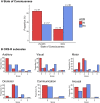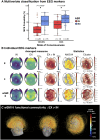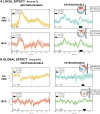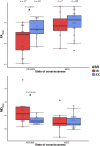Habituation of auditory startle reflex is a new sign of minimally conscious state
- PMID: 32582938
- PMCID: PMC7364741
- DOI: 10.1093/brain/awaa159
Habituation of auditory startle reflex is a new sign of minimally conscious state
Abstract
Neurological examination of non-communicating patients relies on a few decisive items that enable the crucial distinction between vegetative state (VS)-also coined unresponsive wakefulness syndrome (UWS)-and minimally conscious state. Over the past 10 years, this distinction has proven its diagnostic value as well as its important prognostic value on consciousness recovery. However, clinicians are currently limited by three factors: (i) the current behavioural repertoire of minimally conscious state items is limited and restricted to a few cognitive domains in the goldstandard revised version of the Coma Recovery Scale; (ii) a proportion of ∼15-20% clinically VS/UWS patients are actually in a richer state than VS/UWS as evidenced by functional brain imaging; and (iii) the neurophysiological and cognitive interpretation of each minimally conscious state item is still unclear and debated. In the current study we demonstrate that habituation of the auditory startle reflex (hASR) tested at bedside constitutes a novel, simple and powerful behavioural sign that can accurately distinguish minimally conscious state from VS/UWS. In addition to enlarging the minimally conscious state items repertoire, and therefore decreasing the low sensitivity of current behavioural measures, we also provide an original and rigorous description of the neurophysiological basis of hASR through a combination of functional (high density EEG and 18F-fluorodeoxyglucose PET imaging) and structural (diffusion tensor imaging MRI) measures. We show that preservation of hASR is associated with the functional and structural integrity of a brain-scale fronto-parietal network, including prefrontal regions related to control of action and inhibition, and meso-parietal areas associated with minimally conscious and conscious states. Lastly, we show that hASR predicts 6-month improvement of consciousness. Taken together, our results show that hASR is a cortically-mediated behaviour, and suggest that it could be a new clinical item to clearly and accurately identify non-communicating patients who are in the minimally conscious state.
Keywords: auditory startle reflex; cortically mediated state; disorders of consciousness; habituation; minimally conscious state.
© The Author(s) (2020). Published by Oxford University Press on behalf of the Guarantors of Brain.
Figures






Similar articles
-
Coherence in resting-state EEG as a predictor for the recovery from unresponsive wakefulness syndrome.J Neurol. 2016 May;263(5):937-953. doi: 10.1007/s00415-016-8084-5. Epub 2016 Mar 16. J Neurol. 2016. PMID: 26984609
-
Intrinsic functional connectivity differentiates minimally conscious from unresponsive patients.Brain. 2015 Sep;138(Pt 9):2619-31. doi: 10.1093/brain/awv169. Epub 2015 Jun 27. Brain. 2015. PMID: 26117367
-
Neural correlates of consciousness in patients who have emerged from a minimally conscious state: a cross-sectional multimodal imaging study.Lancet Neurol. 2016 Jul;15(8):830-842. doi: 10.1016/S1474-4422(16)00111-3. Epub 2016 Apr 27. Lancet Neurol. 2016. PMID: 27131917
-
Electrophysiological investigations of brain function in coma, vegetative and minimally conscious patients.Arch Ital Biol. 2012 Jun-Sep;150(2-3):122-39. doi: 10.4449/aib.v150i2.1374. Arch Ital Biol. 2012. PMID: 23165873 Review.
-
Minimally conscious state or cortically mediated state?Brain. 2018 Apr 1;141(4):949-960. doi: 10.1093/brain/awx324. Brain. 2018. PMID: 29206895 Free PMC article. Review.
Cited by
-
Towards modern post-coma care based on neuroscientific evidence.Int J Clin Health Psychol. 2023 Jul-Sep;23(3):100370. doi: 10.1016/j.ijchp.2023.100370. Epub 2023 Feb 3. Int J Clin Health Psychol. 2023. PMID: 36817874 Free PMC article.
-
Research hotspots and frontiers of neuromodulation techniques in disorders of consciousness: a bibliometric analysis.Front Neurosci. 2024 Jan 8;17:1343471. doi: 10.3389/fnins.2023.1343471. eCollection 2023. Front Neurosci. 2024. PMID: 38260028 Free PMC article.
-
Aberrant brain-heart coupling is associated with the severity of post cardiac arrest brain injury.Ann Clin Transl Neurol. 2024 Apr;11(4):866-882. doi: 10.1002/acn3.52000. Epub 2024 Jan 19. Ann Clin Transl Neurol. 2024. PMID: 38243640 Free PMC article.
-
Pain anticipation is a new behavioural sign of minimally conscious state.Brain Commun. 2024 Sep 16;6(5):fcae311. doi: 10.1093/braincomms/fcae311. eCollection 2024. Brain Commun. 2024. PMID: 39346020 Free PMC article.
-
Novel approaches to prediction in severe brain injury.Curr Opin Neurol. 2020 Dec;33(6):669-675. doi: 10.1097/WCO.0000000000000875. Curr Opin Neurol. 2020. PMID: 33105151 Free PMC article. Review.
References
Publication types
MeSH terms
LinkOut - more resources
Full Text Sources
Medical
Miscellaneous

